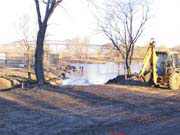For the past 12 years, Hudson County has been trying to restore the portion of the Raritan Bay Estuary that runs through western portion of Lincoln Park.
“You should have seen this place when I first started working here awhile back,” said Ken Jennings, Jr., assistant chief for the Hudson County Division of Parks, last week. “This place was filled with junk.”
So unattractive was the portion of the park sandwiched between Route 440 and St. Peter’s College’s practice fields that Jennings was often the only one who would walk in the area.
“There have been some serious changes since then,” Jennings said.
The debris has since been cleared and restoration work is now underway on the tidal pond, which serves as a link between the Hackensack and Hudson rivers.
“We want to restore the quality of the water and bring back the salt marshes,” said Mariano Vega, Hudson County director of public resources. “The county wants to bring it back to the way it was.”
According to Jennings, the tidal pond in Lincoln Park was a victim of the state’s efforts to cut down the mosquito population.
“The state decided to fill up the marshes to keep the mosquitoes from breeding,” remarked Jennings.
“Unfortunately, they filled it with whatever they had.”
Jennings added that the nearby highways, like Route 440, have added to the contamination problem created by the original dumping.
“There is a lot of silt coming in from the roadways,” Jennings stated. “Throughout the [Raritan] Estuary there is sediment that has been contaminated with pollutants over the years.”
The Raritan Estuary covers the area from Hackensack River and the Meadowlands to the Hudson River and the Newark Bay.
Vega said the county is taking a three-point approach to the restoration of the tidal pond at Lincoln Park.
“Number one is the fish,” said Vega. “The plan is also to restore the general wildlife of the area and the plant life.”
Vega noted that the area, once restored, would serve as a flyway for birds.
“It would be ideal for birds which are migrating to Alaska and Argentina,” Vega said.
Jennings said that the clean-up of the tidal pond area is nearing completion. These efforts include the removal of reed grass, which Jennings described as an “invasive grass.”
To be planted in place of the reed grass will be a breed called spartina, Jennings said. Spartina is several tall and tough cord grasses native to Florida. They colonize salt and freshwater marshes.
“The county is going to plant other native, aquatic plants in the area,” Jennings said.
Jennings stated that the tidal pond, which connects the Hudson and Hackensack Rivers, serves as path way for a number of breeds of fish.
“Some of the fish that use the tidal pond live in salt water, but spawn in fresh water,” Jennings explained, giving as an example carp which spawns in the Hackensack River.
“People have been seeing carp between eight and 15 pounds,” Jennings stated.
With the restoration of the plant life, according to Jennings, shrimp will move back in, and the food chain will build itself back up to its former strength.
Vega said a plan of action for the area has been established for the restoration for the whole area, of which the work on the tidal pond in Lincoln Park is a part. Jennings said the grounds surrounding the pond would be reforested with trees friendly to salt marshes, along with the leveling of the area top help the pond expand.
However, this work would be done by the U.S. Army Corps of Engineers, and much work still has to be done before the next phase of the project is started.
“It sounds pretty simple: Just go in and level the ground,” Jennings stated. “But the Corps and the Department of Environmental Protection have to do studies.”
Among the studies required one would be on the fish life currently occupying the pond, and this, Jennings pointed out, can only be done in the summer months.
“I estimate the whole thing would probably take two years,” said Jennings.
Jennings said the county is planning to repair the three aging bridges which go over Route 440, connecting the tidal ponds to the rest of Lincoln Park West.
“We’ll probably fix the first two bridges and bring them up to code,” Jennings said. “The third bridge may have to go.”
Jennings added the county would like to repair the bridges so that Lincoln Park could be connected to the Delaware Water Gap Hiking Trail. In addition to the bridge repairs, walking paths are in the process of being built around the tidal pond. These paths will eventually be connected to a larger path that would, in turn, link to the hiking trail.
“We want to make Hudson County an environmentally friendly county,” said Vega.
